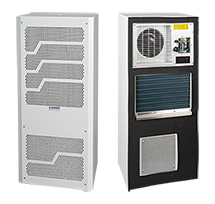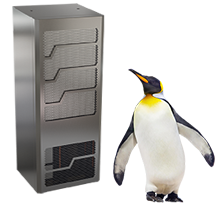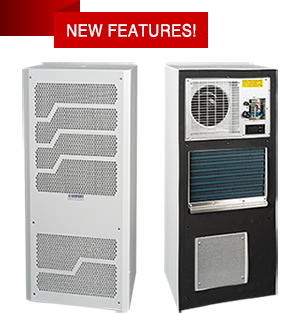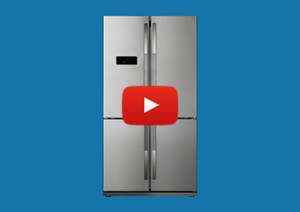Newsletter Volume 5 Issue 2

 In this issue:
In this issue:
- AI-Driven Hybrid Cooling Refrigerator
- How To Calculate Required Cooling Power in Enclosures
- Determining Cooling Capacity Needed for Your Enclosure - Part II
- Progressive Enclosure Cooling
Featured video: AI-driven hybrid cooling refrigerator

AI-Driven Hybrid Cooling Refrigerator
Advancements in cooling technology have been made in 2025, including innovations ranging from AI-powered refrigerators to nano-engineered thermoelectrics and energy-efficient chillers. Samsung introduced refrigerators with AI Hybrid Cooling technology, which combines a compressor with a Peltier module to enhance energy efficiency and food preservation.1 Researchers at the Johns Hopkins Applied Physics Laboratory, in collaboration with Samsung Research, unveiled a breakthrough in solid-state cooling technology using nano-engineered thermoelectrics, that is twice as efficient as current commercial systems.3
Samsung introduced refrigerators with AI Hybrid Cooling technology at CES 2025, which combines a compressor with a Peltier module to enhance energy efficiency and food preservation.1
Source:
1. https://techinsightzone.com/samsungs-ai-powered-refrigerators/
2. https://news.samsung.com/global/samsung-unveils-new-refrigerators-with-innovative-ai-hybrid-cooling-technology-at-ces-2025
3. https://www.channelnews.com.au/ces-2025-samsungs-new-fridges-have-ai-hybrid-cooling-tech/

How To Calculate Required Cooling Power in Enclosures
For Closed Loop Cooling Units
A cooling system with closed loop cooling normally consists of 2 loops; one loop closes the ambient air off and cools and circulates clean air into the enclosure. The second loop uses the ambient air or water to dissipate the heat.
For these applications cooling units and air/water heat exchangers are mainly used.
General Rules
- The only method to reduce enclosure temperature below ambient temperature.
- Suitable for NEMA / IP requirements.
- During planning you need to take the ambient temperature and the generated power loss into consideration. For outdoor applications, consider the solar loading as well.
- Check the performance charts of the product you intend to use to ensure that your system temperature is properly maintained.
The right selection of a cooling unit us determined by the following criteria:
- Required cooling capacity in Watt
- Max. ambient air temperature and desired enclosure air temperature
- Mounting requirements (wall, recessed or top mount)
- Dimensions of cooling unit and enclosure
- Mounting location (indoor, outdoor, free-standing, etc.)
The following simple formula calculates the necessary cooling power:
PK[W] = PV[W] = PR[W]
where,
PK[W] = Cooling capacity of the unit in Watts
PV[W] = Power loss (thermal power generated inside a enclosure by the dissipation loss of components)
PR[W] = Radiant heat gain/loss (heat transfer through the outer casing of the enclosure)
The following simple formula calculates the heat gain/loss:
PR = k • A • ∆T
where,
k [W/m2K] = Coefficient of heat transmission.
A [m2] = Enclosure surface area.
∆T [K] = Temperature difference between ambient air and internal enclosure air.
Important information when utilizing cooling units:
- The enclosure should be sealed to prevent the inflow of ambient air.
- The NEMA /IP rating of the cooling unit and of the enclosure should be the same.
- Use a door contact switch to prevent operation with open doors and consequent excessive accumulation of condensation.
- Ensure that the air inflow and air outflow in the external circuit are not obstructed which would prevent proper heat exchanging at the condenser.
- It also must be ensured that components with a high level of self-ventilation do not direct the air into the cold air outlet of the cooling device.
- Ensure the unit stands straight.
- Setting the temperature to the lowest is not always the best solution. The pre-set value of +35°C is a good compromise ensuring long life of electrical components, efficient operation and minimum condensation. This might also vary depending on the application.

Determining Cooling Capacity Needed for Your Enclosure - Part II
 In the last issue of Cool Cab News we covered an overview of what information is needed to determine the cooling capacity needed for each enclosure application and the type of cooling equipment best suited for those applications.
In the last issue of Cool Cab News we covered an overview of what information is needed to determine the cooling capacity needed for each enclosure application and the type of cooling equipment best suited for those applications.
This second part details the first steps in determining your application's required cooling capacity – choosing your enclosure's parameters.
Steps
- Note the measurements of your enclosure: height, width and depth.
- Note the enclosure material and its thermal conductivity per square meter. See table for common materials.
Mild steel = 5.5 W/m2 • K Plastic = 3.5 W/m2 • K Stainless steel = 3.7 W/m2 • K Double wall = 1.8 W/m2 • K Aluminum = 12 W/m2 • K Other = ___ W/m2 • K - Note the enclosure's physical orientation:
a) Free-standing single cabinet
b) Single cabinet mounted to a wall
c) Start or end cabinets in a row of cabinets
d) Start or end cabinets in a row of cabinets, mounted to a wall
e) An enclosure in a row of enclosures, but not on either end (a middle unit)
f) An enclosure in a row of enclosures, but not on either end, mounted to a wall
The next issue of Cool Cab news will follow up with the next steps– choosing parameters specific to your application's orientation and temperature parameters. Alternatively, this calculator does the entire calculation.

Progressive Enclosure Cooling
 The SoliTherm Progressive line is designed for indoor and outdoor applications. Cooling capacities range from 1,000 BTU/hr to over 20,000 BTU/hr. Housing is available in 304 stainless steel or powder coated steel. Internal components are corrosion resistant.
The SoliTherm Progressive line is designed for indoor and outdoor applications. Cooling capacities range from 1,000 BTU/hr to over 20,000 BTU/hr. Housing is available in 304 stainless steel or powder coated steel. Internal components are corrosion resistant.
They are listed as UL Type 12, 4, 3R and 4X. Features include a programmable digital controller, integrated condensate evaporation package and optional heater.
Now with new features. Click here to learn more.
For aggressive or polluted environments, various filter holders and filter media are available. View Air Conditioner Accessories for details.
If you have a question about enclosure cooling for your specific application, Seifert Systems' technical staff would be glad to speak with you. Email us at info.us@seifertsystems.com or call 401-294-6960 .
Please email suggestions for technical subjects you would like to suggest for this newsletter to this link: Newsletter Editor
